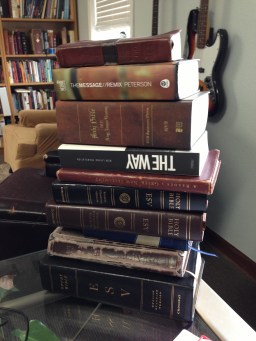The Christian Booksellers Association announced the top ten selling Bible translations from 2012 in the United States recently:
2012 – Based on Dollar Sales
- New International Version
- King James Version
- New Living Translation
- New King James Version
- English Standard Version
- Holman Christian Standard Bible
- New American Standard Bible
- Common English Bible
- Reina Valera 1960
- The Message
2012 – Based on Unit Sales
- New Living Translation
- New International Version
- King James Version
- New King James Version
- English Standard Version
- Common English Bible
- Holman Christian Standard Bible
- New American Standard Bible
- Reina Valera 1960
- New International Readers Version
A few things stood out to be about these lists:
1. Readability – The top two translations (both in terms of dollar sales and unit sales) are the NIV and NLT, both translations that prioritize readability over literal translation.
2. KJV/NKJV tradition – In pockets of American Christianity, the KJV is considered to be the only choice, with perhaps an allowance of the NKJV for the youth. This is based
on a preference for the group of manuscripts (called the Byzantine or Received text) that the KJV is based on. I was surprised to see this tradition so near the top of the 2012 list.
I wonder if the Gideon’s use of the KJV and NKJV had something to do with it. If you aren’t familiar with them, the Gideons are a parachurch organization that gives away Bibles in hotels, near schools, doctor offices… really anywhere they can, for free. And since the KJV has no license fees, they can get more bang for their buck.
3. Competing literalist translations – The HCSB, ESV, and NASB all are looking for the same market (those wanting a more literal translation of the Hebrew, Aramaic, and Greek), but seem to be splitting the pie. The HCSB is the official translation of the Southern Baptist Convention, the ESV is favored by the younger Reformed crowd, and the NASB is the translation of choice for an older group of evangelicals who like inductive Bible study. I use the ESV 99% of the time in teaching, and think that it’s star is rising, as influential groups like AWANA and Bible Study Fellowship switched to it this year.
4. Reina Valera 1960 and Spanish translations – I certainly am no expert on Spanish translations of the Bible, but I wonder if the market is there for an updated and more readable translation of the Scriptures in Spanish. If anyone knows of one, I’d appreciate the heads-up, so I can help be a resource when asked about what Spanish translation to recommend.
(HT: Thom Rainer)

Community Bible Study (CBS) also switched to ESV from NIV last year. They are in the process of revising all their studies.